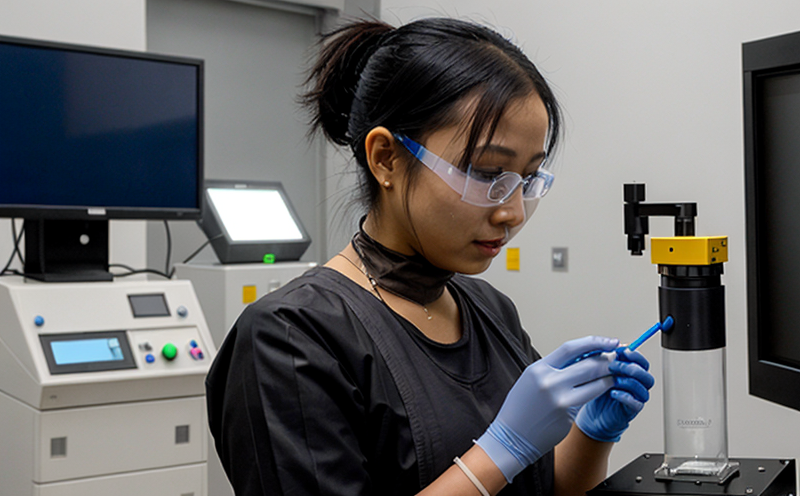DIN EN 689 Workplace Air Analysis of Nanoparticle Concentrations
The DIN EN 689 standard provides a comprehensive framework for the analysis of nanoparticle concentrations in workplace air, focusing on ensuring occupational safety and compliance with regulatory standards. This service is particularly critical for industries dealing with nanomaterials, as it helps identify potential risks associated with inhalation exposure.
Understanding the intricacies of nanotechnology necessitates an in-depth knowledge of how nanoparticles behave under various environmental conditions. The standard outlines detailed procedures to collect and analyze air samples containing nanoparticles, ensuring accurate measurement and interpretation. This process involves several key steps:
- Sampling: Airborne particles are collected using specialized samplers designed to capture nanomaterials efficiently.
- Preparation: The sampled materials undergo meticulous preparation for analysis, including size reduction techniques tailored to handle nanoparticle characteristics.
- Analytical Techniques: Various advanced analytical methods such as scanning electron microscopy (SEM), transmission electron microscopy (TEM), and laser diffraction are employed to characterize the nanoparticles in terms of size distribution and morphology.
- Data Interpretation: The collected data is then analyzed to determine compliance with occupational exposure limits specified by international standards like OSHA, EPA, and other relevant bodies.
Occupational safety is paramount when dealing with nanomaterials. Exposure to nanoparticles can lead to various health issues, making it essential to monitor and manage such risks effectively. The DIN EN 689 standard ensures that workplaces are equipped with robust monitoring systems capable of detecting even the smallest particles.
This service not only aids in regulatory compliance but also plays a crucial role in safeguarding employee health by providing accurate data on nanoparticle concentrations. By adhering to this standard, organizations can implement appropriate control measures and protect their workforce from potential hazards.
The implementation of DIN EN 689 requires specialized equipment and trained personnel who understand the nuances of nanotechnology and its applications. Our laboratory is fully equipped with state-of-the-art instruments and experienced professionals capable of delivering reliable results that meet the highest industry standards.
Why Choose This Test
- Precision and Reliability: Our laboratory uses cutting-edge technology to ensure precise measurements of nanoparticle concentrations, providing reliable data for decision-making.
- Compliance Assurance: By adhering strictly to DIN EN 689 standards, we help clients meet regulatory requirements and avoid potential legal issues.
- Expertise in Nanotechnology: Our team consists of specialists with extensive experience in nanomaterials testing, ensuring accurate interpretation of results.
- Custom Solutions: We offer tailored services to suit specific client needs, whether it's for research or operational compliance.
- Comprehensive Reporting: Detailed reports are provided, including recommendations for mitigation strategies and further actions if necessary.
- Confidentiality: Client information and data are kept strictly confidential, ensuring peace of mind regarding proprietary information.
- Sustainability Focus: Our testing methods aim to minimize environmental impact while providing accurate results.
- Supportive Services: We offer additional support services such as training programs for personnel involved in nanomaterial handling and use.
Selecting DIN EN 689 Workplace Air Analysis of Nanoparticle Concentrations ensures that your organization takes a proactive approach to occupational safety and compliance. Partner with us to ensure you are meeting all necessary standards while maintaining high levels of operational efficiency and employee well-being.
International Acceptance and Recognition
The DIN EN 689 standard is widely recognized internationally, contributing to the harmonization of nanomaterials testing across different regions. Its acceptance by regulatory authorities worldwide makes it a cornerstone for ensuring occupational safety in industries dealing with nanotechnology.
This international recognition enhances the credibility and acceptance of test results obtained from our laboratory. Organizations that comply with DIN EN 689 standards can confidently demonstrate their commitment to worker health and safety, thereby fostering trust among stakeholders.
The standard's broad acceptance also facilitates easier collaboration between multinational companies operating across different countries, as they can rely on consistent testing methodologies and procedures. This uniformity in approach ensures that all parties involved are working towards the same goals, promoting a more cohesive and efficient global nanotechnology sector.
Our laboratory is dedicated to maintaining the highest level of accuracy and reliability in our analyses, ensuring that we meet or exceed international standards. By choosing DIN EN 689 Workplace Air Analysis of Nanoparticle Concentrations, you are aligning your operations with best practices recognized globally.
Use Cases and Application Examples
The implementation of DIN EN 689 Workplace Air Analysis of Nanoparticle Concentrations has numerous practical applications across various sectors. Here are some key use cases:
- Manufacturing Industries: For industries like electronics, automotive, and aerospace, where nanomaterials are used extensively, this test helps monitor occupational exposure during production processes.
- R&D Labs: Research institutions can utilize this service to assess the safety of new nanomaterial formulations before commercialization.
- Healthcare Facilities: Hospitals and medical research centers may benefit from this analysis to evaluate risks associated with handling nanomaterials in clinical settings.
- Environmental Agencies: Regulatory bodies use these tests to enforce compliance with occupational exposure limits and ensure public safety.
- Corporate Compliance Departments: Companies can leverage this service as part of their internal audits to verify adherence to health and safety policies.
- Academic Institutions: Universities conducting nanotechnology research require accurate data for academic publications and grant applications.
- Government Agencies: Public sector organizations involved in occupational health initiatives can rely on this service to protect workers' rights and promote safe working conditions.
In summary, DIN EN 689 Workplace Air Analysis of Nanoparticle Concentrations is a vital tool for maintaining occupational safety and compliance across diverse industries. By integrating this standard into your quality management systems, you can ensure that your organization remains at the forefront of nanotechnology advancements while prioritizing employee well-being.





